You are here
Russia: A Migration System with Soviet Roots

St. Basil's Cathedral in Moscow. (Photo: Y. Nakanishi)
The Russian Federation appeared on the world map as an independent state at the end of 1991, following the dissolution of the Soviet Union. Even as it grappled with huge political and economic upheaval, Russia suddenly found itself home to a massive number of “immigrants” from former Soviet states. With little experience managing international migration flows to guide policy in this area initially, Russia has been at the center of transformative shifts in migration, all while its government has worked to solidify a comprehensive migration management system.
The history of international migration in Russia did not begin with the breakup of the Soviet Union. Therefore, analysis of migration patterns in the Russian Federation, as in other former Soviet republics, should begin in earlier times, when they formed a single state. Many sociodemographic issues and ethnopolitical conflicts in former Soviet republics, as well as migration flows between them after the breakdown of the Soviet Union, are to a large extent the result of Soviet-era migration. Today, Russia maintains strong cultural, political, and economic ties with residents of former Soviet states—reflected in ongoing migration patterns—which it works to strengthen with its citizenship policies.
Migration in the Soviet Era
The borders between the Soviet republics never acted as barriers to migration, fulfilling only an administrative function. Soviet migration policy focused mainly on internal migration, for the purpose of redistributing the labor force. Millions of people moved between the Soviet republics as the state attempted to regulate internal migration primarily by stimulating resettlement to sparsely populated regions with considerable deposits of natural resources, including to northern and far-eastern Russia and to Kazakhstan. Mobility was partly regulated by the registration (propiska) system, although this system did not significantly inhibit migration, and internal and inter-republic movement developed based on factors including family connections and job opportunities. Rural residents continuously flowed to urban areas, where the population became more concentrated.
Migration between Russia and other Soviet republics during this period occurred in two stages. The first lasted from the beginning of the 1950s to the mid-1970s, when Russia lost 2.7 million people to other Soviet republics. Migrants from Russia flowed to Ukraine and Belarus for postwar reconstruction and development, to the Baltic republics, to Kazakhstan for the development of fallow land, and to Central Asia to build newly industrialized economies.
Meanwhile, migration from other Soviet republics gradually grew, starting a second stage—one of in-migration to Russia. This phase, occurring between 1975 and 1991, increased the population of Russia by 2.5 million. Initially, these flows were directed to remote, resource-rich areas aided by the offer of state benefits. Later, they were spurred by state reallocation of investments to the development of oil and gas fields in West Siberia and mineral resources elsewhere in eastern Russia.
Many students from other socialist states and from developing countries attended Russian universities, and, to a smaller degree, universities in other Soviet republics. In 1960, 13,500 foreign students were in the Soviet Union, a number that rose to 180,000 by 1990 (of whom 70 percent studied in Russia). In 1960, the People’s Friendship University of Russia was established to train students from newly independent countries in Africa and Latin America, and more than 60,000 people from 165 countries studied there during the Soviet period.
In addition, temporary labor migration took place in limited fashion between the Soviet Union and other socialist countries. Starting in the late 1970s, tens of thousands of people (mostly from Bulgaria, North Korea, and Vietnam) migrated annually to major Soviet cities and the remote reaches of Russia. In 1981, the Soviet Union and Vietnam signed an employment and professional training agreement under which more than 100,000 Vietnamese worked in the seven Soviet republics over the course of a decade.
Aside from labor agreements, the hallmark of the external migration regime during the Soviet period was the "Iron Curtain," which entailed borders closed in both directions. Beginning in the late 1920s, the Soviet government strictly limited emigration. The first change came with President Mikhail Gorbachev’s perestroika in the late 1980s, a period that saw an easing of restrictions on travel from the Soviet Union. First, residents were allowed to travel abroad for short periods of time. Gradually, the Iron Curtain was lifted, at first primarily to allow ethnic Germans to move to Germany and Jews to depart for Israel or the United States. From 1987 to 1991, 134,000 people moved from Russia to Israel, 102,000 to Germany, 15,000 to the United States, and about 20,000 to other countries, according to the Soviet Ministry of Interior.
Shifting Flows, New Policies after the Breakup of the Soviet Union
Box 1. Russian Migration Statistics: Shifting Methodology and Data Limitations
The way officials measure migration to, from, and within Russia has changed significantly since the early 1990s, with implications for data analysis. Until 1997, every person who changed their place of residence for more than 45 days was counted as a migrant; this included a large number of individuals in the country temporarily for business, study, or personal visits. Starting in 1997, only migrants with permanent-type registration were counted, regardless of the duration of their stay. A further methodological change meant that, beginning in 2011, temporary migrants registering and residing in a place for nine months or more were also included in statistics. This change to the definition of “migrant” is one of the main factors behind the dramatic increase in the number of international migrants recorded starting in 2011 (see Figure 1).
Official data collection on emigration from Russia faces an additional challenge: many emigrants do not declare their move and thus go uncounted in Russian statistics. For instance data collected by 14 former Soviet countries of destination suggest that nine times more people left Russia between 2011 and 2013 than official emigration statistics reflect.
Following the collapse of the Soviet Union, migration policy in the region underwent serious transformation. The newly independent post-Soviet states began setting up their own institutions to regulate migration and citizenship, and it soon became clear that Russian immigration law needed reform.
The first post-Soviet migration legislation in Russia was devoted to issues of displacement. In 1992, Russia signed the 1951 United Nations Convention Relating to the Status of Refugees and its 1967 protocol, and in 1993, it codified elements of these in new laws on refugees and internally displaced persons. In 1993, a law was passed on freedom of movement and choice of residence, expanding opportunities for internal migration, and a 1996 law on procedures for entry and exit enshrined liberal changes that began during perestroika.
Meanwhile, the legal status of foreign citizens was still regulated by a 1981 Soviet law and a 1991 decree that were no longer compatible with the rapidly changing reality. Comprehensive rules on residence and work for foreigners in Russia were lacking, and procedures for issuing residence permits were obsolete. To fill these gaps, Russia implemented a set of commonly used migration management tools, including entry visas, work permits, visas to attract foreign employees, registration of place of stay for citizens and foreigners, and permits for permanent and temporary residence.
Post-Soviet Shuffle
The early 1990s was a period of intense resettlement of Russian-speaking migrants living in other former Soviet republics, particularly the repatriation of people who had left Russia and their descendants. In addition, political reforms in these countries—including laws elevating languages other than Russian to official language status—acted as strong push factors, as did armed conflicts in the region, including in the Caucasus, Moldova, and Tajikistan. These caused a flow into Russia of refugees and internally displaced persons of different ethnic groups. Although ethnic Russians represented about 60 percent of arrivals to Russia, a significant number were Russian speakers of other ethnic groups. In 1994, more than 1.1 million people moved to Russia, and net migration peaked that year at 810,000 (see Figure 1).
Migration also occurred for economic and family reasons. And by the end of the 1990s, Russia faced completely new challenges: rising illegal migration (mainly labor) and threats of terrorism.
Figure 1. Migration Flows to and from Russia, 1991–2015
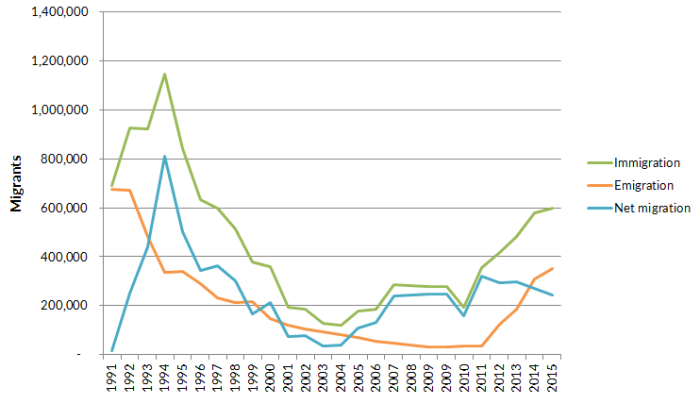
Note: Immigration figures refer to inflows of migrants who stay in Russia longer than one year.
Source: Federal State Statistics Service (Rosstat), “International Migration,” updated July 8, 2016, available online (in Russian).
Since the breakup of the Soviet Union, movement to and from Russia has happened mostly within the region. Nationals from former Soviet republics represented more than 90 percent of all arrivals and more than two-thirds of departures between 1991 and 2015. Russia received about 11.8 million immigrants and lost 5.3 million emigrants over this period. From 2001 to 2010, permanent migration decreased markedly compared to the 1990s.
In the period since 1989, the migrant population in Russia has undergone fundamental changes (see Table 1). The populations from Ukraine, Belarus, and the Baltic states have shrunk, while inflows from Central Asia and Transcaucasia (Armenia, Azerbaijan, and Georgia) have grown—from 15 percent of all immigrants in the 1990s to almost 40 percent from 2011-15. This shift reflects a gradual transition of temporary labor migrants into permanent immigrants, as well as mortality among elderly immigrants from Ukraine and Belarus. In 2010, the main countries of birth of international migrants were Ukraine (about 3 million people, or 26 percent of all migrants), Kazakhstan (2.5 million, 22 percent), Uzbekistan (1.1 million, 10 percent), and Belarus and Azerbaijan (740,000, or 6.6 percent each).
Table 1. Size and Percent Change (%) of Population in Russia, by Country of Birth, 1989-2010
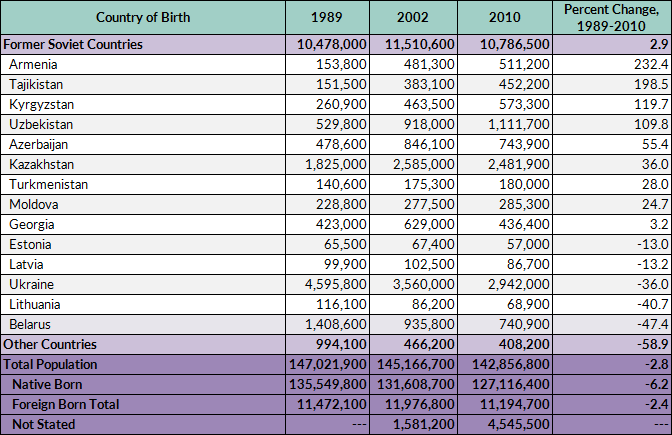
Source: 1989 Census data from Demoscope Weekly, accessed May 16, 2017, available online (in Russian); 2002 and 2010 All-Russia Census data from Rosstat, accessed May 16, 2017, available online here and here (in Russian).
Temporary Migration: Filling New Labor Demands
Immediately after the collapse of the Soviet Union, labor migration to Russia was modest in scale. Regulation of labor migration began in 1994, when 108,000 work permits were first given to foreigners. From 1995 to 2000, the annual number of work permits fluctuated between 106,000 and 186,000 (see Figure 2). One-third of migrant workers came from Ukraine, and more than half from countries outside the former Soviet Union, mainly China, Turkey, and former Yugoslav countries. The number of workers from Central Asian states was small until the late 1990s, as was the number from the countries of Transcaucasia.
Figure 2. Russian Employment Permits Issued to Foreign Workers, 1994-2015
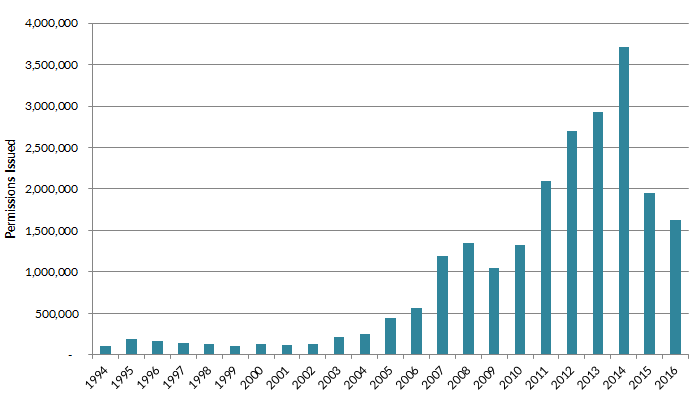
Note: Beginning in 2010, these include patents and permits for highly skilled workers.
Source: Unpublished reports obtained by the authors from Rosstat and the former Federal Migration Service of Russia (now the Directorate General on Migration Issues in the Ministry of Interior).
In the early post-Soviet years, it was difficult to draw a clear line between temporary and permanent labor migration, and between the legal and illegal employment of immigrants from the former Soviet republics. This was due to the still-porous nature of borders, the large number of people with unresolved citizenship (i.e., bearing Soviet-era passports), and a lack of laws governing the legal status of foreigners. A new understanding of labor migration came at the beginning of the 21st century, when an improving Russian economy led to increased demand for labor, especially in construction, transport, and services. Citizens of other former Soviet republics that were not faring as well economically (except for Kazakhstan) were drawn to Russia in search of higher salaries.
Before long, new laws and institutions were implemented to more precisely define the legal status of labor migrants and to oversee labor migration management. A 2002 law standardized the registration and issuance of work permits, resulting in an increase from 175,000 labor migrants in 2001 to 570,000 in 2006. Despite this heightened demand for (and supply of) labor, the work permits process proved cumbersome and the effects were felt particularly strongly by migrants from former Soviet states who previously had enjoyed relatively free movement—as well as by their employers. Foreign-born individuals could only obtain a work permit with the invitation of an employer, who was first required to obtain a license for hiring foreign nationals. As a result, most migrant workers from former Soviet republics worked without registration, aided by the fact they were entitled to visa-free entry and could stay in Russia for up to 90 days and extend the period anew simply by leaving and immediately re-entering the country. Meanwhile, citizens of countries outside the former Soviet Union accounted for a disproportionately large share (more than half) of all authorized foreign workers.
Curbing Illegal Immigration
Between 1998 and 2000, 1.5 million migrants resided in Russia illegally—a number that swelled to between 3 million and 5 million in the early 2000s. In an effort to reduce illegal immigration, the government simplified the procedure for obtaining work permits and registering temporary residence for migrants from former Soviet countries. Starting in 2007, citizens of countries with visa-free entry could apply for a permit without a sponsoring employer, while nationals of other states required an employer invitation. Meanwhile, the government also introduced quotas on the number of permits issued to migrants traveling visa free. The changes allowed hundreds of thousands of people to regularize their status, and work permit grants doubled between 2006 and 2007, from 570,000 to 1.2 million. As a result, the authorized share of the temporary migrant-workforce rose to 35-40 percent in 2007, up from 5-10 percent in 2000. By 2007, former Soviet countries accounted for almost three-quarters of all work permits.
Opening New Labor Channels
In 2010, migration authorities introduced two new ways to access the labor market: a “patent” system for citizens of former Soviet countries with visa-free entry, and simplified rules for the recruitment of highly qualified specialists.
Initially, the patent allowed immigrants to perform domestic work in private households, and was not limited by quota. Affordable monthly payments (equivalent to about US$27, from 2010 to 2014) made patents a convenient and popular way to live and work lawfully in Russia. In 2014, 2.4 million patents were issued, exceeding the number of work permits by almost 1 million. In 2015, the patent system was expanded to cover employment for entrepreneurs and companies. At the same time, regional authorities were allowed to establish their own patent fees. Moscow set one of the highest fees, which stood at 4,200 rubles (about US$73) in late 2015-16.
Foreign highly skilled specialists make up a very small group, and most are from countries whose citizens require a visa to enter Russia. Wages vary by category of worker: most make around 2 million rubles per year (about US$34,860), while some make significantly less, around 58,000 rubles per month (about US$1,011). These workers can obtain special residence permits and bring their families. In 2012-15, the largest groups were from China (20 percent) and Vietnam (13 percent).
In recent years, Russia has become one of the leading importers of labor. Temporary migrants mostly hold low-paying jobs with poor working conditions, which are unattractive to the native population. In 2012-14, unskilled workers, primarily in trade and construction, represented as much as 30 percent of all labor migration. There were perhaps more than 4 million foreign workers in 2014, up from 3 million the year before. Most workers issued patents and work permits in 2011-15 were citizens of Uzbekistan (45 percent), Tajikistan (nearly 20 percent), or Ukraine (9 percent). Citizens of former Soviet countries made up at least 90 percent of the total flow of authorized migrants. The other leading origin countries were China, Turkey, Vietnam, and North Korea.
Migration during Economic Crisis
The Russian economic crisis that began in fall 2014 made life more difficult for immigrants. A nearly two-fold depreciation of the ruble against leading world currencies led to a sharp reduction in migrant remittance sending and reduced labor demand. The number of migrant workers shrank by at least one-third between 2014 and 2015, with countries such as Ukraine, Azerbaijan, and Moldova experiencing a more than 50 percent drop in their nationals in Russia.
In 2015, new regulations made it more difficult and costly for migrants to access the Russian labor market. All potential employees are now required to pass Russian language and history tests, undergo a medical exam, and purchase health insurance. In some regions, a migrant worker on a patent now pays a yearly fee equal to two months’ salary to remain.
Migration Today: Trends and Debates
Today, the foreign-born population in Russia is technically the third largest in the world, after that of the United States and Germany. However, a significant number of "international migrants" in Russia fall into this category only in a statistical sense; many moved to Russia before the collapse of the Soviet Union. Their migration at the time was within national borders, thus it was internal migration. As of 2010, 11.2 million residents were born outside Russia, 93.4 percent of them natives of former Soviet republics. Nearly 95 percent of the total foreign-born population (excluding temporary labor migrants) held Russian citizenship.
The number of foreigners with valid temporary and permanent residence permits has grown in recent years, surpassing 1 million by the end of August 2016. In 2015, almost 80 percent of residence permit holders were from six countries: Ukraine (approximately 306,000 people, or 29 percent of the total), Uzbekistan (138,000, 13 percent), Armenia (116,000, 11 percent), Tajikistan (100,000, 10 percent), and Kazakhstan and Azerbaijan (with 85,000, or 8 percent apiece).
Because so many are international migrants only in the technical sense, it is useful to look at the number holding foreign citizenship. In January 2016, almost 10 million citizens of other countries stayed in Russia, with varying durations of stay and statuses. Of these, 38 percent (3.7 million) had been in Russia for more than one year. Many foreigners legally reside in Russia without residence permits, including students (242,500 were enrolled in the 2015-16 academic year, most from other former Soviet states) and persons with long-term extendable visas.
Net Migration
Amid the considerable movement of migrants between former Soviet republics, Russia has gained population, a significant development for this aging society; net authorized immigration from other former republics resulted in an increase of 7.5 million people between 1991 and 2015. The main contributors were Kazakhstan and Uzbekistan (due to new migration flows, as well as modified counting methods), and Ukraine. Meanwhile, over the same period Russia experienced a net loss of more than 1 million nationals from countries outside the former Soviet Union (see Table 2).
Table 2. Net Migration in Russia by Period, 1991–2015
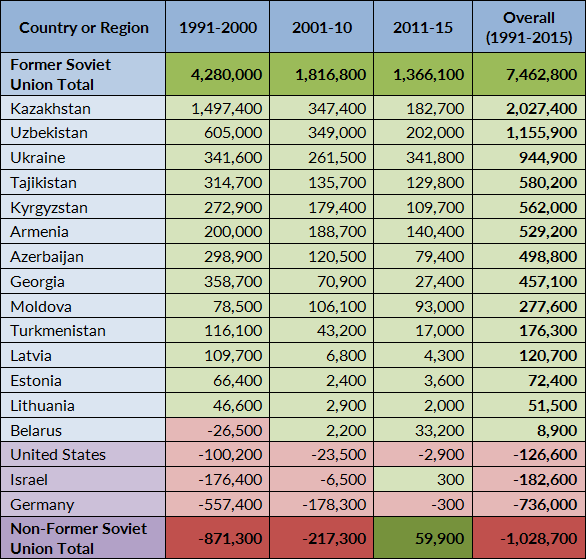
Note: Green represents positive net migration, while red represents negative net migration. Estimates of overall net migration vary based on methodology, with another estimate based on the demographic balance method placing the figure at 9 million from 1991 to 2015.
Source: For data since 1997, see Rosstat, “International Migration,” updated July 8, 2016, available online (in Russian); data prior to 1997 from unpublished reports obtained by the authors from Rosstat and the former Federal Migration Service of Russia (now the Directorate General on Migration Issues in the Ministry of Interior).
In a number of ways, migration has been beneficial for Russia, countries of origin, and migrants themselves. Immigration allowed Russia to compensate for almost 60 percent of the natural population loss experienced following the collapse of the Soviet Union. In the 1990s, Russia benefitted from a significant redistribution of human capital, owing to the higher skill and education levels of arriving Russian-speaking migrants. In this way, the loss of skilled labor due to mass migration beyond the borders of the former Soviet Union was offset. However, migration flows in the past decade (with the possible exception of forced migrants from Ukraine, who arrived in 2014–15) have been very different, with lower education levels on average.
Emigration from Russia
In 2015, 10.6 million people born in Russia lived abroad, about three-quarters in former Soviet republics. Of the 2.4 million living beyond the former Soviet republics, 1.1 million were in Germany, more than 400,000 in the United States, and about 115,000 in Israel. Many emigrants maintain a dwelling along with business and work ties in Russia, and retain Russian citizenship.
Overall, between 1991 and 2015 the top destination countries were Ukraine (29 percent), Germany (14 percent), and Kazakhstan (13 percent). A distinctive feature of Russian emigration to non-former Soviet states in the 1990s was its geographical concentration and pronounced ethnic component. Almost 70 percent of these emigrants moved to Germany or Israel, mainly as permanent immigrants. Many migrants from Russia also left for the United States, and until the mid-1990s more than half obtained refugee status. These shares varied considerably by period, and in 2001-10 the top destination country was Germany, which received almost 30 percent of all Russian emigrants.
By the mid-2000s, the migration outflow to countries outside the former Soviet Union decreased significantly, as many of those who intended to take advantage of repatriation programs (mainly to Israel and Germany) had already done so, and immigration programs for former Soviet citizens began to be curtailed. Over the years, Russian citizens have also placed value on other attractive destinations, including Austria, Canada, Finland, France, Italy, and Spain. In the past two decades, the nature of migration has changed and has acquired a more distinctly economic character.
Citizenship Policy
Laws on the acquisition of Russian citizenship, similar to the policies that regulate entry and work authorization, have undergone significant changes since the Soviet collapse. From 1992 to 2015, about 8.5 million people acquired Russian citizenship. Many residents of post-Soviet states have viewed attaining Russian citizenship as a desirable goal. Until 2002, naturalization was regulated by an extremely liberal citizenship law, allowing individuals to apply for citizenship by submitting an application to the Ministry of Interior if in Russia or to Russian consulates if abroad. Hundreds of thousands of residents in former Soviet republics took advantage of this opportunity, allowing them to avoid bureaucratic difficulties while moving to and settling in Russia.
A new law on citizenship in 2002 and subsequent amendments in 2003 simplified naturalization for most applicants, requiring only a temporary residence permit and a waiting period of no more than 1.5 years. In accordance with international agreements, hundreds of thousands of citizens of Belarus, Kazakhstan, and Kyrgyzstan obtained Russian nationality, some just three months after arriving in Russia. As of late 2011, all foreigners applying for Russian citizenship must have a permanent residence permit, a requirement that extended the application process but in general did not slow the simplified citizenship acquisition process.
Figure 3. Naturalizations by Category, (%), 2009-15
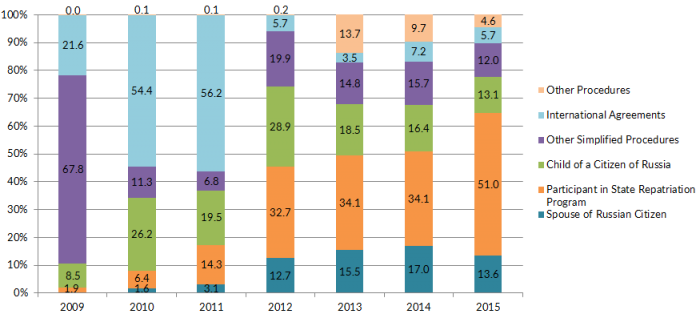
Source: Unpublished reports obtained by the authors from Rosstat and the former Federal Migration Service of Russia (now the Directorate General on Migration Issues in the Ministry of Interior).
In 2006, Russia launched a program of assistance for voluntary “resettlement of compatriots” (see Box 2). Fifty-one percent of foreigners naturalized through the Ministry of Interior in 2015 were participants in this program, followed by spouses of Russian citizens (14 percent) and applicants with a Russian-citizen parent (13 percent). The number of people who acquired citizenship through marriage increased from 700 in 2009 to 35,000 in 2016, suggesting that fraudulent marriages may have grown in popularity as a way to more easily obtain citizenship.
Box 2. The State Program of Assistance for Resettlement of Compatriots
The state program of assistance for voluntary resettlement of “compatriots” living abroad, launched in 2006, is the only comprehensive initiative to encourage immigration to Russia. At its core is a pronounced ethnic component (proximity to Russian culture, Russian “roots," or similar ties). The program also emphasizes the importance of potential migrants’ professional and educational attainment.
Interest in the program grew after several legislative changes significantly complicated access to citizenship for most immigrants. Other naturalization channels were either significantly reduced or ceased to exist after 2009.
In summer 2014, the program was opened up to the victims of the conflict in southeast Ukraine who had arrived in Russia as forced migrants and had been granted temporary (more than 300,000 in total from 2014-15). Thus, citizens of Ukraine became the major group of new participants of the State Program in 2014-15.
Currently, more than half of all persons acquiring citizenship are participants in the resettlement program. By the end of 2015, some 530,000 people had participated in the program, most having naturalized.
From 1992 to 2015, Kazakhstan and Ukraine were the top origins for immigrants granted Russian citizenship though the Ministry of Interior, with 1.7 million and 1.1 million respectively. Naturalized immigrants from four Central Asian countries accounted for 1.6 million of the total, and 1.1 million were from the three Transcaucasian states.
Looking Ahead
In June 2012, the President of Russia approved the State Migration Policy Concept. The concept, which sets policy until 2025, aims to make immigration policy more balanced and includes the development of legislation focused on various long-term and temporary (primarily labor) migration flows. Implementation has required about 50 legislative changes, and substantial amendments were made to laws on the legal status of foreign citizens, entry and exit procedures, and citizenship. In addition, numerous international agreements—both bilateral and collective—apply to national legislation in the areas of migration, travel and visa issues, legal status, labor migration, citizenship concerns, readmission, and more.
As of this writing, most of the concept’s goals have not been achieved and major challenges remain. There are still no immigration programs with diversified terms for different categories of migrants. The bulk of migrant workers come to Russia under more generic terms; for example, health-care workers and low-skilled seasonal workers must fulfill the same rules to access the labor market. Effects from labor migration are estimated only on the basis of annual fees paid by workers for the patents. Integration of migrants receives little policy attention, though the simplified citizenship acquisition process makes integration needs difficult to discern.
Today, Russia stands at another crossroads, and will need to make decisions in two key areas: how migration should be regulated, and how many (and what kind of) migrants Russia needs.
Sources
Arefiev, A.L. 2012. International Students in Russian Universities. Report at the 3rd World Forum of Foreign Graduates of Soviet and Russian Universities. Moscow: Institute of Demography of National Research University Higher School of Economics. (In Russian)
Chudinovskikh, Olga. 2014. Use of Administrative Data Sources to Measure Migration in Russia. Presentation at Economic Commission for Europe Conference of European Statisticians, Work Session on Migration Statistics, Chisinau, Moldova, September 10-12, 2014.
Chudinovskikh, Olga. 2015. Collecting Data on Labor Migration in Sample Surveys of the Population. Voprosy Statistiki 9: 12-22. (In Russian)
Chudinovskikh, Olga and Mikhail Denisenko. 2014. Population Mobility in the Commonwealth of Independent States: Whither Common Migration Policy. CARIM-East Research Report. CMR Working Papers No 74(132). Warsaw: Centre of Migration Research, University of Warsaw.
Heleniak, Timothy. 2002. Migration Dilemmas Haunt Post-Soviet Russia. Migration Information Source, October 1, 2002. Available online.
International Organization for Migration (IOM). 2002. Migration Trends in Eastern Europe and Central Asia: 2001-2002 Review. Geneva: IOM. Available online.
Kuzminov, Y.I. et al. 2013. Migration Policy. In Strategy 2020: New Growth Model – a New Social Policy, eds. V.A. Mau and Y.I. Kuzminov. Moscow: Delo Publishing House, Russian Federation. Available online (In Russian).
Light, Matthew. 2016. Fragile Migration Rights: Freedom of Movement in Post-Soviet Russia. New York: Routledge.
Mansoor, Ali and Bryce Quillin, eds. 2007. Migration and Remittances: Eastern Europe and the Former Soviet Union. Washington, DC: World Bank. Available online.
Mazyrin, V.M. 2004. The Vietnamese in Russia: Lifestyle, Problems, and Prospects. In Indochina: Trends of Development, ed. Nadezhda Vektimirova. Moscow: ISAA. (In Russian)
Mukomel, V. 2005. Migration Policy of Russia: Post-Soviet Context. Moscow: Institute of Sociology of the Russian Academy of Sciences. (In Russian)
Panda, Ankit. 2014. Russian Emigration Spikes in 2013-2014. The Diplomat, July 25, 2014. Available online.
Popov, V. 1996. Passport System of the Soviet Serfdom. Novy Mir, Issue 6, 1996. Available online (In Russian).
Russian Federation. 2006. On Setting for 2007 the Permissible Share of Foreign Workers Used by Managing Subjects, Carrying Out Activity in Sphere of Retail Trade on the Territory of the Russian Federation. Decree No. 683, November 15, 2006. (In Russian)
Ryazantsev, S. 2007. Labor Migration in the CIS and Baltic States: Trends, Consequences, Regulation. Moscow: The Formula Right. (In Russian)
United Nations Department of Economic and Social Affairs (UN DESA). 2015. Trends in International Migrant Stock: Migrants by Origin and Destination, 2015 Revision (United Nations database, POP/DB/MIG/Stock/Rev. 2015). Available online.
Zayonchkovskaya, Z.A. and E.V. Tiuriukanova. 2009. Immigration: A Way to Salvation or a Trojan Horse? In Human Development Report. Moscow: Russian Federation.


